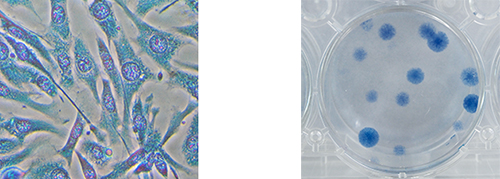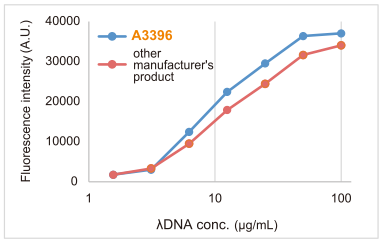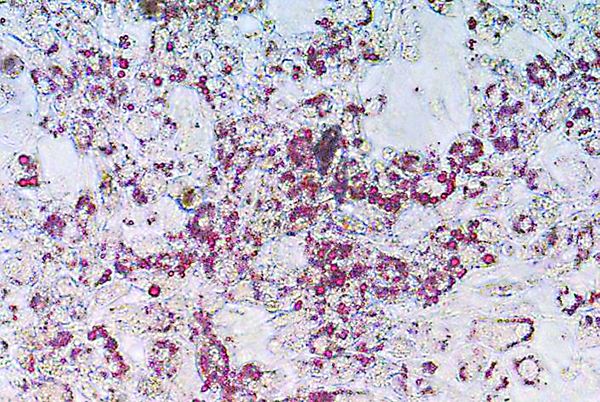สารทดลองทางชีววิทยาของเซลล์ ผลิตภัณฑ์สารย้อมสี, for Cell staining

สารทดลองทางชีววิทยาของเซลล์ ผลิตภัณฑ์สารย้อมสี, for Cell staining
สารทดลองทางชีววิทยาของเซลล์ ผลิตภัณฑ์สารย้อมสีเรืองแสง
M2392 / Methylene Blue Solution [for Cell Staining] 100mL [M2392]
A3396 / Acridine Orange Solution [for Cell Staining] 5 mL
Acridine Orange เป็นสารย้อมสีกรดนิวเคลียสที่ใช้ในการย้อมสีเซลล์ที่ตายแล้ว เมื่อใส่สารนี้เข้าไปด้วยอัตราส่วน 1 ส่วนต่อ 3 คู่เบสของดีเอ็นเอสายคู่ ก็จะปล่อยแสงเรืองสีเขียวออกมา (Ex: 500 nm, Em: 520 nm) และเมื่อจับกับ RNA หรือดีเอ็นเอสายเดี่ยวแล้ว ก็จะปล่อยแสงเรืองสีแดงออกมา (Ex: 460 nm, Em: 650 nm) Acridine Orange มีคุณสมบัติด้านการกลายพันธุ์ ดังนั้นเรานำเสนอผลิตภัณฑ์ในรูปแบบสารละลายที่สามารถป้องกันการกระเซ็นขณะตวงวัด
O0483 / Oil Red O [for Biochemical Research] 25g
Oil Red O เป็นสารย้อมสีเอโซประเภทหนึ่งที่ใช้กันอย่างแพร่หลายในการทดสอบหาเซลล์ไขมันหรือไขมันที่เป็นกลางมาตั้งแต่ในอดีต ซึ่งจะย้อมไขมันที่มีความเป็นขั้วต่ำ มีวิธีการใช้งานที่ง่ายและสะดวก หลังจากใส่น้ำยาย้อมสีแล้ว เพียงแค่นำไปทำความสะอาดก็สามารถย้อมสีได้เลย อีกทั้งยังง่ายในการมองแยกออกจากไขมันด้วยตาเปล่า นอกจากนี้ หลังจากย้อมสีแล้ว ยังสามารถชะสารย้อมสีได้โดยใช้ไอโซโพรพานอล และกำหนดปริมาณสะสมของไขมันได้ด้วยการวัดการดูดกลืนแสง
ข้อมูลผลิตภัณฑ์
สารทดลองทางชีววิทยาของเซลล์ ผลิตภัณฑ์สารย้อมสี for Cell staining
Cell Staining Dye
Methylene Blue Solution (Methanol Solution) [M2392] fixes and stains cells at the same time, so you can save fixation before staining. It stains nuclei blue.
Product
M2392 Methylene Blue Solution (Methanol Solution) [for Cell Staining]
Application

Figure. NIH/3T3 cells stained by the above method
1. Culture cells in a 6-well plate.
2. Remove medium from the plate and wash it with PBS(-) twice.
3. Remove PBS(-) from it, add 1mL of M2392 and stain cells for 15 minutes.
4. Remove M2392 from it and wash it with deionized water twice.
Please adjust staining time and volume according to cells.
Because some cells need to be fixed separately, preliminary tests should be performed.
Dead Cell Staining Dye
Acridine orange is a nucleic acid staining dye that is used to identify dead cells. It intercalates with the double-stranded DNA base pairs at a ratio of 1:3 and is capable of emitting green fluorescence (Ex: 500 nm, Em: 520 nm). It also emits red fluorescence (Ex: 460 nm, Em: 650 nm) when bound to RNA or single-stranded DNA. Since acridine orange is mutagenic, this product is supplied as a solution that prevents it from splashing during weighing.
Product
A3396 Acridine Orange Solution [for Cell Staining]
Application: The method of staining cells by A3396

NIH3T3 cells stained by A3396
1. Remove the medium from the culture plate and wash the cells twice with cold PBS(-). Remove the PBS(-).
2. Add PBS(-) and Acridine Orange solution [A3396] (1/50th of the volume of the added PBS(-)) and incubate for 15 minutes.
3. Remove the staining solution and wash the cells twice with PBS(-).
4. Add PBS(-) and observe the cells under a fluorescence microscope.
Please adjust the staining duration and the volume of the solution according to the cell density.
Some cells may require prior fixation; therefor optimization of the protocol according to your need is recommended.

λDNA was stained using either the acridine orange solution [A3396] or the other manufacturer's product, and the fluorescence measured from two experiments was compared (Ex:500nm, Em:520nm).
The results indicated that A3396 stained better than the other manufacturer's product.
Cellular Lipid Staining Dye
Oil red O is a diazo dye which has been widely used for staining fat cell and lipids since long ago. This lysochrome (fat-soluble dye) red dye can be used for staining of neutral triglycerides and low polar lipids. Oil Red O staining is done on fresh or frozen samples, since alcohol fixation removes lipid. Its usage is simple, and requires only washing after adding the staining solution, which makes it easy to identify lipids visually.
Furthermore, accumulation of lipids can be quan-tified by eluting the dye using isopropanol after staining and measuring the absorbance.
Product
O0483 Oil Red O [for Biochemical Research]
Application

10 days later of addition of media for differentiation to 3T3-L1 cell and then stained by 1mg/mL of O0483.